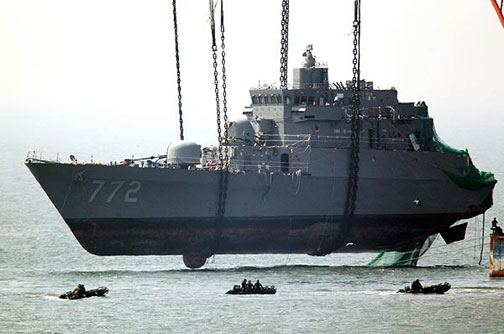
December 2010
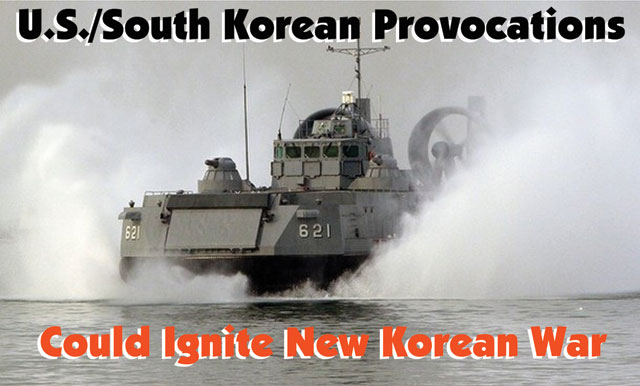
(Photo: Chung Sung-Jun/Getty Images)
Bogged down in a losing war in Afghanistan, despite tripling U.S. forces there, and having lost the midterm elections to right-wing Republicans who deride him as weak, U.S. president Barack Obama may delude himself into thinking he could score points by striking a hawkish pose on North Korea. For his part, South Korean president Lee Myung-bak, a virulent Cold War anti-Communist, won office railing against “appeasement” of the North and has since staged one incident after another.
Judging from diplomatic correspondence recently published by Wikileaks, decision makers in Seoul and Washington seem to have convinced themselves that North Korea is about to collapse (as they have often miscalculated in the past). They want to push it over the brink. In the process, they may bring the region – and the world – to the brink of war. In this perilous situation, we reiterate our call to Defend North Korea against imperialist war provocations and sanctions, and demand: All U.S. troops out of Korea!
The latest casus belli (cause of war) was an exchange of artillery fire on Yonphyong Island just off the western coast of North Korea. According to the account broadcast around the world, at 2:30 p.m. local time on November 23, North Korean artillery shells suddenly began raining down on the island, held by South Korea. Two South Korean soldiers were reported killed, and two bodies of island residents were later found. After 100-plus rounds were fired from the North, the South Koreans responded by lobbing scores of shells at a North Korean military base.
The Western press screamed bloody murder about North Korea targeting civilians. South Korean legislators demanded heavy-duty retaliation. A White House statement quoted President Obama saying he was “outraged,” and that the North Korean government is “an ongoing threat that needs to be dealt with.” Liberals and conservatives in the U.S. joined in denouncing the North’s “belligerence.” “Diplomats” (usually a codeword for spies) speculated about effects of leadership transition in the North. Korea “experts” psychoanalyzed DPRK leader Kim Jong Il.
The whole rigamarole is one big smokescreen, to create a fog of war.
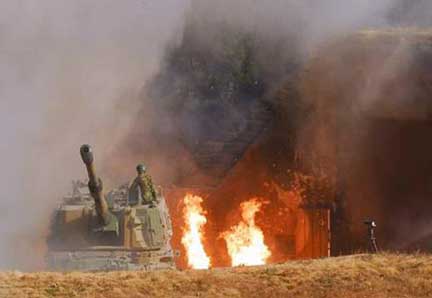 South
Korean K-9 gun outside bunker hit by North Korean shelling in response
to artillery barrage from Yonphyong Island, November 23. (Photo: Reuters)
South
Korean K-9 gun outside bunker hit by North Korean shelling in response
to artillery barrage from Yonphyong Island, November 23. (Photo: Reuters)
Repeating a common refrain, British foreign secretary William Hague condemned the North Korean government for its “unprovoked attack.” Yet provoked is exactly what it was. The North Korean salvos came just one hour after the South Koreans unleashed a massive artillery barrage from Yonphyong Island, as part of the “Hoguk” military exercises. (The island is home not only to 1,350 fisher folk but also to a South Korean military base with 1,000 soldiers.)
The DPRK had warned repeatedly, including in an urgent telephone message to South Korean military leaders at 8 a.m. that morning, that “if even a single shell of the enemy is fired inside the territorial waters of the DPRK, it will take a prompt retaliatory strike.” Moreover, days later, the South Korean National Intelligence Service admitted it knew from electronic surveillance that the North was preparing to respond to the South Korean artillery by shelling the island. But the South Koreans went ahead anyway, daring the North to respond.
The New York Times did have a story reporting a North Korean statement that “the South ‘recklessly fired into our sea area’,” and that “The North blamed the South for starting the exchange; the South acknowledged firing test shots in the area but denied that any had fallen in the North’s territory.” The story went on to say that “The attack on Yeonpyeong came as 70,000 South Korean troops were beginning an annual nationwide military drill called Safeguarding the Nation. The exercise has been sharply criticized by Pyongyang as ‘simulating an invasion of the North’ and ‘a means to provoke a war’.” But after a few hours this dispatch disappeared from the Times’ web page, so one could only find it by searching. It was never published in the paper.
“Senior American officials” said the North Korean attack was “premeditated,” since the South Korean maneuvers were announced in advance. Premeditated is right – about the U.S. and South Korean provocation. They knew what the consequences would be of holding war “games,” including artillery barrages, just off the North Korean coast in its territorial waters, and they went ahead anyway.
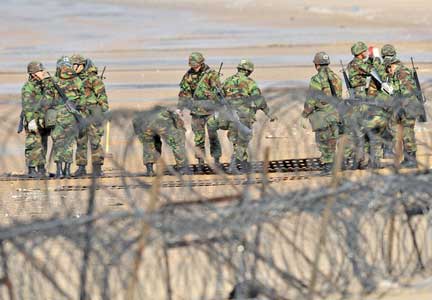 South Korean troops practice invasion of
North. Laying down metal tracks for tanks during landing exercise,
November 28. (Photo: Jung Yeon-je/AFP)
South Korean troops practice invasion of
North. Laying down metal tracks for tanks during landing exercise,
November 28. (Photo: Jung Yeon-je/AFP)
South Korean spokesmen ridiculed the North’s assertion that the Hoguk exercises were simulating an invasion. Yet photos of the drill show soldiers practicing landing exercises. Where do you suppose they might be preparing to land? Is the South Korean military perhaps planning to invade … South Korea?
The media accounts have also passed over a basic fact: Yonphyong Island is located just seven miles off North Korea’s coast. The South Korean artillery shells fell even closer. That’s roughly the distance from Wall Street to the tip of Staten Island. What do you expect would happen if an enemy power staged a live-fire military exercise in the New York harbor?
And Yonphyong sits at the mouth of the North Korean deep water harbor of Haeju. What would be the response if the North unleashed artillery barrages from an island facing the South Korean port of Incheon? The fact that South Korea occupies this and other coastal islands is a standing military provocation.
U.S. spokesmen accused the DPRK of violating the 1953 armistice agreement that ended combat in the Korean War. Yet North Korea never agreed that the islets hugging its western coast belonged to South Korea. The “Northern Limit Line” claimed by the South is just a few miles offshore, well to the north of the Military Demarcation Line. It was unilaterally imposed by the United States at the end of the Korean War.
The DPRK was unable to prevent South Korean occupation of the islets, now turned into a string of military outposts targeting the North, because in 1953 it didn’t have a navy or air force. But it has always insisted that these islands belong to North Korea, being well within its territorial waters, as they certainly are.
Washington and Seoul linked this incident to the sinking of the South Korean naval vessel Cheonan last March, claiming both are North Korean “provocations.” Not only does the DPRK vehemently deny having anything to do with the sinking of the Cheonan, the available evidence upholds its denial. This was discussed in a previous article (“Defend North Korea Against U.S. War Threats and Sanctions,” The Internationalist No. 31, Summer 2010). Since then, an independent South Korean newspaper, The Hankyoreh, has done an independent investigation that makes mincemeat of the government’s claims (see article, “What Sank the Cheonan?”). Opinion polls in South Korea report that less than one-third of the public believes the official story.
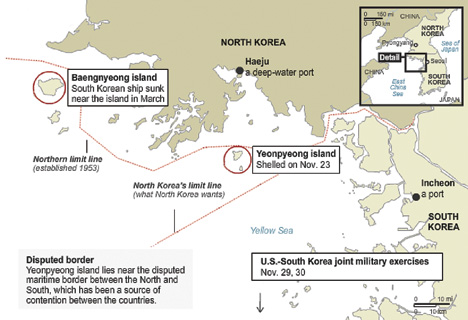 Map:AP
Map:AP
Adding up the Cheonan and Yonphong Island incidents, the imperialists and their South Korean auxiliaries have been pressuring the Chinese government to pin the blame on North Korea, which it has refused to do. Both China and North Korea are bureaucratically deformed workers states, and China is the main trading partner for the North, enabling the DPRK to circumvent the imperialist sanctions orchestrated by the United Nations. For Beijing to abandon Pyongyang would be an act of class treason of the highest order – and suicidal as well, for the imperialists’ ultimate target is the People’s Republic of China, which they avidly seek to reconquer for capitalism.
Beijing issued a statement objecting to the U.S./South Korean military exercises because they were being held within China’s “economic zone.” Indeed, in the area where the South Korean and U.S. navies held joint maneuvers last March before the Cheonan sunk, North Korea is barely 200 miles from China’s Shandong peninsula. Last week’s U.S./South Korean maneuvers involving the U.S. nuclear supercarrier George Washington were held in the East China Sea. Next week’s U.S./Japanese operations will be in the Yellow Sea, between Japan and China. All these “war games” are aimed at containing the rising influence of China, and with one false (or deliberate) move, the “games” could easily turn into the real thing.
The background to the current crisis is U.S. imperialism’s longstanding vendetta against North Korea over nuclear weapons. The DPRK has sought to develop the capacity to generate nuclear power because since the demise of the Soviet Union it is chronically short of fuel, lacking hard currency to buy oil on the capitalist world market, while it does have uranium. It has sought to develop nuclear weapons as a deterrent to the imperialists, who devastated the North during the Korean War (see “U.S. War Against North Korea Never Ended,” in this issue), who subject North Korea to punishing sanctions, who refuse to sign a peace treaty and are constantly plotting counterrevolution.
While giving no political support to the Stalinist rulers of the DPRK, we defend North Korea’s right to have nuclear weapons to defend itself. Why should the United States, the only power ever to use atomic bombs in war, slaughtering hundreds of thousands of Japanese civilians at Hiroshima and Nagasaki, have a monopoly on “weapons of mass destruction”? The purpose is to subjugate the world to the diktat of U.S. imperialism. And Washington wants to deprive North Korea of its nuclear deterrent so that the U.S. can finish the Korean war by destroying the DPRK with impunity.
Skirmishing over North Korea’s nuclear program has been going on for almost two decades. Prior to the 1990s, the main deterrent to imperialist conquest of North Korea was the certainty that this would mean war with the Soviet Union. With the USSR destroyed by counterrevolution, the regime headed by Kim Il Sung and his son Kim Jong Il rightly figured it had better get the bomb to ward off attack. It did, to great consternation in the White House and the Pentagon.
In the latest installment of the ongoing saga, Pyongyang invited an American scientist, Siegfried Hecker, the former head of the U.S. nuclear weapons laboratories at Los Alamos, to visit the DPRK’s most sensitive nuclear site, the reactor at Yongbyon. Hecker had been there before, and certainly could recognize a weapons lab if he saw one. He reported that the North was building a 25-30 megawatt electric light-water reactor, and that it had a small, quite modern industrial facility with 2,000 centrifuges producing low-enriched uranium for the new reactor. The North Koreans wanted to show this to a qualified nuclear expert before U.S. intelligence agencies announced that they had “discovered” another “secret bomb factory.”
Instead, the imperialists screamed that this was another “provocation,” it was Kim Jong Il bragging that he had a “second route to making nuclear weapons.” Yet Hecker in his report on his November 12 visit made clear that North Korea had shut down its plutonium producing reactor and “has apparently decided not to make more plutonium or plutonium bombs for now.” And while a light water reactor could produce some nuclear fuel, it is “much less suitable” for bombs than what they had before. In fact, when the U.S. tried to stop the DPRK from getting nuclear weapons in the 1990s, it offered to build a light-water reactor to supply the North’s power needs!
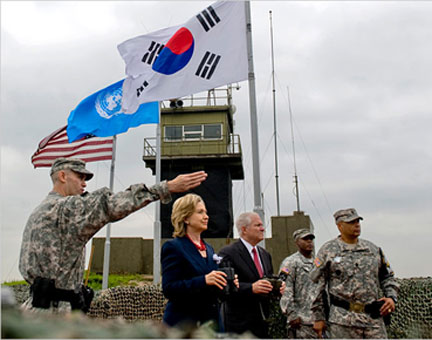 U.S.
secretary of state Hillary Clinton and war minister Robert Gates at the
DMZ for some nuclear sabre-rattling, July 21.
U.S.
secretary of state Hillary Clinton and war minister Robert Gates at the
DMZ for some nuclear sabre-rattling, July 21.
(Photo: Reuters)
So officials in Washington and Seoul add up the sinking of the Cheonan, centrifuges at Yongbyon and the North Korean shelling of Yonphyong Island to make a case for … what? Following the last incident, South Korea president Lee sacked his minister of defense and announced “robust” new rules of engagement would be forthcoming. Yonhap news agency said the South was “planning further artillery drills, ‘including waters close to the Yellow Sea border’” with the DPRK. The clear intent is to provoke a new “attack” by the North.
Some imperialist geostrategists worry about where this is all headed. The New York Times (24 November) noted early on:
“[F]or Mr. Obama, much stronger responses, including a naval quarantine of the North, carry huge risks. A face-off on the Korean Peninsula would require tens of thousands of troops, air power and the possibility of a resumption of the Korean War, a battle that American officials believe would not last long, but might end in the destruction of Seoul if the North unleashed artillery batteries near the border.”
Yet the U.S. government still seems to be caught in the “brief bubble of sole superpower fantasy,” as one analyst (Robert Rothkopf) put it. Whatever Washington’s intentions are, full-scale fighting could easily break out. The threat by the new South Korean war minister on December 3 to “retaliate immediately” against the DPRK, including air strikes in the North, “until they completely surrender,” would do it. The U.S. boarding a Korean freighter on the high seas could also set it off. This is a war waiting to happen, and a new Korean war would not stay limited to the peninsula for long.
In response to the stepped-up imperialist onslaught against North Korea, China called for resumption of the six-party talks including South Korea, Japan, the U.S. and Russia. This was contemptuously dismissed by the White House, whose spokesman declared that the U.S. is “not interested in stabilizing the region through a series of P.R. activities.” The Chinese English-language newspaper Global Times (2 December), wrote: “The Cold War ended 20 years ago…. But the US, South Korea and Japan are still dealing with Pyongyang with an old Cold War mentality.” The Beijing bureaucrats are still pursuing the Stalinist pipedream of “peaceful coexistence” with imperialism, an illusion that contributed greatly to the demise of the USSR. They fail to see, or pretend not to see, that Washington views Beijing through the same lens.
On the left in the United States, some reformist groups that follow the political line of Pyongyang call on the U.S. to “sign a peace treaty with the DPRK” (Workers World Party statement, 1 December). The Party for Socialism and Liberation says that “normalization of relations” between Pyongyang and Washington “seemed like a realizable goal in the last months of the Bill Clinton administration in 1999 and 2000” (ANSWER Coalition statement, 26 November). Wrong. It wasn’t about to happen under Democrat B. Clinton, and it sure won’t under Democrats Obama and H. Clinton. Faced with a challenge to their class domination, the imperialists will go for “peace” only when they have been defeated, as in Vietnam.
The fact that Washington refuses to sign a peace treaty is certainly indicative of its “Cold War mentality,” but for leftist opponents of U.S. imperialism to call for that reveals the same dangerous illusions that Washington and Seoul can be pressured into peacefully coexisting with North Korea. The war threat comes from the South Korean militarists and U.S. imperialists, who are bent on the destruction of the DPRK. Revolutionaries and class-conscious workers should defend North Korea’s right to nuclear weapons, call for an end to the imperialist sanctions against North Korea and demand immediate withdrawal of all U.S. forces from Korea, Japan, Okinawa, Philippines, Indochina and all of East Asia.
Above all, a real defense of the deformed
workers
states of North Korea, China and Vietnam cannot be successful on the
narrow
nationalist program of the Stalinists. What is ultimately required is
the
international extension of the revolution to the imperialist centers of
Japan,
North America and Europe. In the immediate crisis, it is urgent for
South
Korean workers to mobilize against the looming war threat. Spokesmen
for the
Korean Confederation of Trade Unions (KCTU) joined with other labor and
civic
groups in a press conference December 1 calling for “no war” and
calling
“dialogue
the only way to recover stability and peace on the Korean Peninsula” (The Hankyoreh [Seoul], 1 December). The
vast majority of South Korea’s population opposes war moves against the
North. But
what’s needed is to bring the power
of the militant labor movement into the streets to stop
the drive to war.
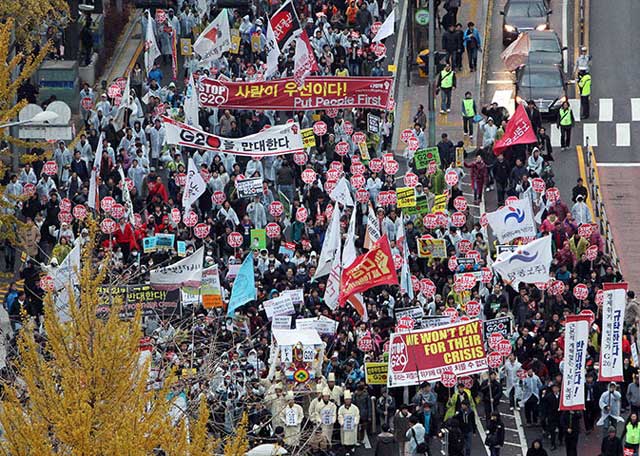
Thousands
of
South
Korean
workers
march
against G20 meeting in Seoul, November 11. (Photo:
AP)
South Korean workers have demonstrated repeatedly that they have the strength to bring the capitalist economy to a grinding halt. In December 1996 over a million workers walked out and stayed out to protest anti-labor laws and increased powers to spy and police agencies. Another general strike in June 2001 protested austerity measures ordered by the World Bank and the International Monetary Fund, as well as calling for abolition of the infamous National Security Law. Again in 2006, the KCTU (and particularly the militant transport workers) struck against a law increasing the use of temporary workers. Most recently Korean workers held militant protests against the G20 summit in Seoul, and have repeatedly demonstrated against the just-signed Korean-U.S. Free Trade Agreement. What’s needed to mobilize this tremendous force against the South Korean militarists and chaebol capitalists is a class-struggle leadership.
The League for the Fourth International calls for revolutionary reunification of Korea under workers rule, through a proletarian political revolution against bureaucratic misrule in the North and a social revolution overturning capitalism in the South. Such a struggle would send shock waves to Japan, where antiwar sentiment among the population remains strong due to the experience of Hiroshima and Nagasaki; to Okinawa, where a labor-led struggle could drive out U.S. military bases; and to China, where it could inspire tens and hundreds of millions of workers to rise up against capitalist exploitation in the special economic zones and the threat of capitalist counterrevolution engulfing the entire country.
And in the United States, the Internationalist Group warns, as we did even during the 2008 election campaign when the left caved in to the popularity of Barack Obama, that Democrats, Republicans and all capitalist parties and politicians are responsible for the endless imperialist wars. The war machine can only be stopped through proletarian action (of which the May Day 2008 West Coast port strike against the Iraq and Afghanistan war was a small token) to defeat U.S. imperialism and bring down the whole imperialist system through international socialist revolution.
To lead such a struggle we must build
revolutionary
workers parties on the internationalist communist program of Lenin and
Trotsky,
fighting to reforge the Fourth International. ■
|
Earlier this year, the sinking of a South Korean navy corvette Cheonan off the North Korean coast and the deaths of 46 sailors on board led to a chorus of accusations from Washington and Seoul that it was sunk by military forces of the Democratic People’s Republic of Korea (DPRK). North Korea categorically denied having anything to do with the March 26 sinking of the South Korean warship. Numerous technical experts also questioned the charge of North Korean responsibility. After a so-called “international commission” claimed the Cheonan was sunk by a North Korean torpedo, the U.S. announced new sanctions against the DPRK and provocative naval maneuvers led by the nuclear aircraft carrier USS George Washington. We wrote about the incident and analyzed the contradictory claims against the North in the article, “Defend North Korea Against U.S. War Threats and Sanctions” (The Internationalist No. 31, Summer 2010). Since our article was published the imperialists have continued to use the Cheonan incident in their escalating war propaganda, routinely alleging that North Korea was responsible, as if this were an established fact. However, a Los Angeles Times (24 July) article, “Doubts Surface on North Korea’s Role in Ship Sinking,” reported that the official version of events was being challenged in South Korea itself. One of the doubters is Shin Sang-chul, a former shipbuilding executive who was appointed to the investigating commission by the opposition Democratic Party. Shin was peremptorily removed from the commission when after inspecting the vessel he said that in his opinion, the Cheonan ran aground in the shallow water, and then damaged the hull trying to get off a reef (which is what the South Korean navy originally reported). The defense ministry accused him of “lack of objectivity and scientific logic” and “intentionally creating public mistrust.” Numerous elements of the official story have been challenged. One is the piece of a torpedo propeller fortuitously discovered weeks after the sinking. A physics professor, Seunghun Lee, questioned why there was so much corrosion after less than two months in the water, while the supposed North Korean marking was very clear and on top of the rust. “You could put that mark on an iPhone and claim it was manufactured in North Korea,” Lee scoffed. Also, the marking used an abbreviation common in the South, not in the North. Many asked why the government was refusing to let the press or outside investigators speak with surviving crew members. The Hankyoreh (21 May), a liberal Seoul paper, questioned how it could be that no North Korean submarine or torpedo launch was detected, either by the Cheonan, which is an anti-submarine warfare (ASW) vessel, or by the South Korean ASW base on the nearby Baengnyeong Island, or by U.S. ships that were present in the area following ASW maneuvers (codenamed Foal Eagle) with the South Korean navy. As the controversy continued, more questions have been raised. The South Korean government invited Russia to send a team to investigate, which it did in early June. However, the Russian team concluded that damage to the propellers on the salvaged Cheonan indicated it had scraped the shallow ocean floor; that the torpedo propeller was dubious (markings and rust); that there were significant time discrepancies between sailors’ reports of an explosion and the time code recorded on closed circuit TV images inside the ship; and that the corvette could have touched the antenna of an ocean mine (Hankyoreh¸ 27 July). This would jibe with a report from Beijing suggesting that the South Korean warship could have been sunk by a bottom mine laid by the U.S. The report noted the presence in the U.S.-South Korean maneuvers of a diving support ship, USNS Salvor, of a type frequently associated with the Office of Naval Intelligence (“Did an American Mine Sink the South Korean Ship?” New American Media, 27 May). The National Union of Media Workers and Korean Federation of Journalists set up their own committee to investigate the Cheonan incident. On November 11, HaniTV, a video production unit of The Hankyoreh, put up a documentary on the Internet with material from that inquiry providing a detailed critique of the government’s story. In addition to the questions about the Cheonan’s propellers, the alleged North Korean torpedo propeller fragment and the various times given for the explosion (suggesting tampering with the tape), it questioned the location where the sinking reportedly occurred based on coast guard reports, and noted that based on NASA experiments, a torpedo blast sufficiently strong to slice the ship in two would have mangled sailors’ bodies. Yet none of the survivors or the recovered bodies show signs of this; the sailors who died were drowned, not blown apart. (The video can be seen on the Internet at http://www.youtube.com/watch?v=SDITkTEDVNA). At this point there is still insufficient public evidence to determine who or what sank the Cheonan, which was a warship engaged in hostile military maneuvers against the DPRK. But it can be said with certainty that the account presented by the South Korean government and backed by U.S. authorities is a concocted story. Its purpose is to whip up a war hysteria against North Korea. As noted in our earlier article, “There is a long history of imperialist governments staging provocations or seizing on unrelated events to justify launching a war. Recall how ‘Remember the Maine!’ became the battle cry for the U.S. occupation of Cuba in 1898, after an explosion sank the American battleship in the Havana harbor…. [I]f the provocative U.S.-South Korean military maneuvers escalate into war against North Korea, the war cry will no doubt be ‘Remember the Cheonan!’” In opposing the war moves against North Korea, it is important to expose the fabrications being used to justify them. |
To contact the Internationalist Group and the League for the Fourth International, send e-mail to: internationalistgroup@msn.com
